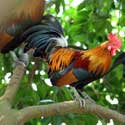
When chickens are allowed to free range, certain breeds fare far better than others, especially in terms of avoiding predators. Ideal characteristics for free ranging chickens include wariness, inconspicuous plumage, acute vision, and foraging ability.
Predator Wariness
Chicken breeds that are best able to evade predators are the wary, high strung, excitable, so-called flighty breeds. They become alarmed more easily than other breeds, and as soon as they feel threatened they look for ways to escape.
Jungle fowl are the ancestors of all our present day chicken breeds and still retain their innate wariness. Large breed Old English Game as near relatives to the jungle fowl, also have acute reflexes. Other wary breeds suitable for a free range flock include Leghorn, Lakenvelder, Egyptian Fayoumi, and Hamburg.
Breeds that are less predator wary are the ones noted as being calm and docile, such as the Brahma, Cochin, Faverolle, and Orpington. Although these and other similarly docile breeds are extremely popular for backyard flocks, they are not as predator wary as their flightier cousins.
Plumage Color
Chickens with white feathers are more highly visible than the more colorful breeds and therefore tend to be the first ones picked off by a predator. This is one reason the most popular strains for free range meat production are colored Cornish hybrids, in contrast to the white Cornish broilers favored by the poultry industry. These free ranging meat strains come in a variety of colors, including barred, black, and gray. Red — such as Cackle’s Red Broiler — is by far the most popular color for free range meat chickens.
Although any dark or patterned breed is more predator resistant than a white chicken, a white chicken of a flighty breed is more predator resistant than a white chicken of a docile breed. White Leghorns and the Leghorn cross Austra White are two examples of white feathered chickens that have strong predator-avoidance instincts.
Ability to See Well
Chickens that are among the least suitable for free ranging are breeds with an abundance of head feathers. While these top hat breeds with their feathery crests are popular for exhibition, and they make spectacular additions to any backyard flock, a full set of head feathers that hang over into a birds’ eyes impede the bird’s ability to see a predator coming, as well as interfere with a fast-getaway. Among the top-hat breeds unsuitable for free ranging are Houdan, Polish, Silkie, and Sultan.
Some well-meaning owners of crested chickens trim back the front feathers to improve a bird’s ability to see. However, crested breeds tend to be rather docile and less inclined than more active breeds to venture far from the coop. Therefore, even when their feathered finery is trimmed back, they are not particularly suited to free ranging.
Foraging Ability
One of the primary benefits of free ranging a flock is to allow the chickens to forage for nourishing things to eat. So there isn’t much point in attempting to free range birds that lack the desire, instinct, or ability to forage. Jumbo Cornish Cross broilers, for example, make excellent meat birds, but they’re rather lazy when it comes to foraging. Further, their white plumage can be a predator attractant, while their cumbersome size hinders any chance for a rapid escape.
Breeds that are excellent foragers include Ameraucana, Ancona, Andalusian, Buckeye, Egyptian Fayoumi, Golden Comet, Hamburg, Old English Game, and Welsumer. Jersey Giants are also good foragers, and they are too heavy to be carried away by a hawk or other raptor. On the other hand, their large size makes them particularly attractive to the larger land predators, such as bobcats and coyotes.
Ideal Free Rangers
Although not all chicken breeds are ideally suited for free ranging, many have good foraging instincts and are otherwise relatively predator resistant. Among them are the brown Leghorn, Egyptian Fayoumi, Olive Egger, Rhode Island Red, Speckled Sussex, Welsumer, and any of the many color varieties of large breed Old English Game.
Note, however, that “predator resistant” is not the same as “predator proof.” No chicken breed is predator proof unless it is enclosed within a predator proof facility, which unfortunately is the opposite of true free range.
And that’s today’s news from the Cackle Coop.
Gail Damerow, author, Storey’s Guide to Raising Chickens, What’s Killing My Chickens?



I realize I’m answering a comment that is a couple years old but I just wanted to say our RIR is the ONLY bird we cannot catch and also evades every predator out there. If you or anyone else is still wondering what to do, go with the Rhode Island Reds.
I have had chickens for 3 yrs now. In the beginning totally free range now mostly fre rang after i built an enclosure they can roam around when nobody home. But mostly free range when i let them out of enclosure. I have had 3 buff orpingtons since the beginning. I have lost about 5 birds to coyotes all red sex links. The sex links have a habit especially cold nights of hunkering down anywhere when the sun goes down and eventually getting eaten by predators unless i can fund them. The orpingtons religiously go in the coop at night no problem, im surprised that in ur article u say they are more predator prone. I would like to get some more birds but want the good insticive orpington mentality but with a little higher egg production. I believe rhode island red is the answer but cannot find any evidence online. Any mor info would be appreciated.